
Management of Post-Prandial Blood Glucose Level Using Some Common Nigerian Thickeners
*Corresponding Author(s):
Onuoha SCDepartment Of Biochemistry, University Of Port Harcourt, Rivers State, Nigeria
Tel:+2348097743819,
Email:sammyonuoha@yahoo.co.uk
Abstract
This study investigated the effect of the consumption of soups made from some Nigerian soup thickeners such as Brachystegia eurycoma (achi), Detarium microcarpum (ofor), Irvingia gabonensis (ogbono), Colocasia esculenta (taro) and Citrullus vulgaries (egusi) on the post-prandial blood glucose level of healthy subjects. The soup thickeners were processed into flour and paste using usual traditional processing method. The soups were consumed on separate days by five subjects after an overnight fast. Three days interval was allowed between the consumption of each test soup. Fasting venous blood glucose were taken at fasting (0 min), and post-prandial blood glucose levels were taken at 30 min intervals for 3 hours; and the blood was analyzed for glucose using FineTest™ strips and glucometer. Compared with the control, Irvingia gabonensis soup elicited significant reduction (p≤0.05) in plasma glucose levels at 90 and 180 min; while the Brachystegia eurycoma had significant reduction only at 180 min. Proximate analysis was also carried out on the six different soup samples used in this study. The percentage crude fiber of the soups compared to the control soup (6.53) was highest in Irvingia gabonensi soup (6.59), while in Brachystegia eurycoma soup it was (2.0), Detarium eurycoma soup (1.30), colocasia esculenta soup (4.0) and Citrullus vulgaries soup (2.80).
Keywords
Irvingia gabonensis; Citrullus vulgaries; Colocasia esculenta; Brachystegia eurycoma; Detarium microcarpum
Introduction
Diabetes mellitus is defined as a chronic metabolic disorder characterized by high blood glucose (hyperglycaemia) and associated with impaired carbohydrate, fat and protein metabolism, resulting from either insufficient or no release of insulin by pancreas in the body [1] . Type II diabetes is predominant, accounting for over ninety per cent (90%) of cases in sub-Saharan Africa. Among the low and middle income countries such as Nigeria, diabetes has been on the increase contributing to eighty per cent (80%) of deaths [2]. A shift in the eating habit, decreased physical activities and emulation of westernized life style has been reported by the World Health Organization (WHO) and Food and Agricultural Organization (FAO) as the major factor leading to the rapid change in diabetes pattern.
Glycaemic index is a system that characterizes how fast carbohydrate is metabolized in a diet, and how fast it can raise postprandial blood glucose in the body. Dietary studies carried out have shown that the carbohydrate contents of lower glycaemic index foods are slowly broken down in the body, and moves into the blood stream at a slower rate. Foods rich in dietary fibre have been accepted to be suitable for diabetics, this is as a result of its low glycaemic index content and minimal rapidly digestible starch content, consumption of such foods have been said to be important in the treatment and prevention of diet related chronic diseases such as diabetes and also shown to cause an improvement in the intestinal mobility [3,4] . Experiments involving both humans and animals encouraged the view that soluble dietary fibre such as guar gum is an important component of our diet, and this importance has been attributed to its ability to modulate the postprandial blood glucose and insulin response in diabetic and non-diabetic individuals [5] .
Thickeners are hydrocolloids or guar gums used to thicken beverages, gravies, sauces and soups. Hydrocolloids are diverse group of long chain polymers with the characteristic of forming viscous dispersion or gel when dispersed in water; they have neutral taste and aroma [6]. In Nigeria, a wide range of thickening agents are available for use by the millions of Nigerians, they include; Brachystegia eurycoma (achi), Detarium microcarpum (ofor), Irvingia gabonensis (Ogbono), Colocasia esculenta (taro) and Citrullus vulgaries (egusi) [7-9]. Most rural dwellers who diet majorly on these seeds have been observed to have clean records of all the nutritional associated diseases and conditions such as obesity, diabetes and so on[10] . Therefore, there is need for more research work to be carried out on these thickeners. The main purpose of this work was to determine the effect of these thickeners on the postprandial blood glucose level of healthy subjects.
Materials And Methods
Subjects
Five healthy subjects were selected to take part in this study. All were in good physical condition and had a family history without diabetes or metabolic disorders. They were not currently under any medication.
Procurement of soup ingredients
The thickeners and other soup condiments where purchased from the popular Oil Mill market in Port Harcourt, Rivers State.
Obtaining ethical approval for the study
The experimental protocol was approved by the ethical committee of University of Port Harcourt, Rivers State.
Obtaining informed consent from the participants
Every participant provided an informed, written consent.
Preparation of soup samples
The procedures used in the preparation of the soups were as close as possible to the traditional method used by people in the rural areas of Nigeria.
Soup condiments used (none thickening agents) include:
- Two cooking spoons red oil
- Half kilogram beef
- Two stock cubes
- One medium size stock fish
- Three table spoons ground crayfish
- One table spoon ground pepper
- Pumpkin leaf
- Water
- Salt to taste
The procedure for the preparation of the soups is summarized in the flow chart given in figure 1.
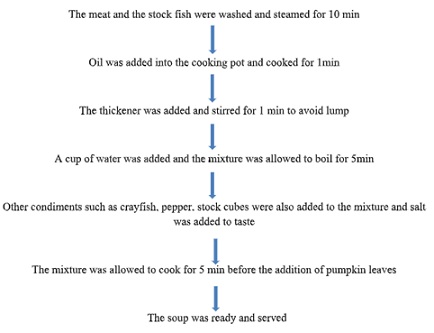 Figure 1: Flow chart for the preparation of the soups.
Figure 1: Flow chart for the preparation of the soups.
Grouping of test meals
The study consisted of six groups of five individuals, with each group representing one of the six soup samples, all prepared as they are locally prepared in Igbo land. These are:
- Group one (control soup) contained no thickener.
- Group two (egusi soup) contained the seed flour of Citrullus vulgaries ‘egusi’.
- Group three (ofo soup) contained the seed flour of Detarium microcarpum ‘ofor’.
- Group four (cocoyam soup) contained the cormel paste of Colocasia esculenta ‘taro’.
- Group five (achi soup) contained the seed flour of Brachystegia eurycoma ‘achi’.
- Group six (ogbono soup) contained the seed flour of Irvingia gabonensis ‘ogbono’.
Feeding of the subjects with the experimental meals
Groups of five volunteers were drawn from a pool of 5 (4 men, one woman). They each took part in two or more experiments, one of which was a control, which were performed in randomized order at least three days apart. The meals were taken over a 10-minute period in the morning after an overnight fast.
Determination of the post-prandial blood glucose level
On arrival on the test days, subjects rested for 10min before the experiment began to enable the blood volume to stabilize. It was ascertained that the subjects had nothing to eat for 12hrs. Cotton wool was used to apply methylated spirit on the finger tips, usually the thumb. Blood lancet was used to prick the fingers; a drop of blood was applied on the circular portion on the test trip. This was displayed on the screen and the result given after 45 seconds from the glucometer.
Fasting blood glucose was taken and subsequently postprandial blood glucose were measured every 30 min for 3 h. Blood glucose was measured using one FineTest glucometer and test strips, with a measuring range of 0 to 600mg/dL (0 to 33.3mmol/L).
Analysis
The proximate analysis of the samples, that is the ash content, crude fiber, protein, moisture, fat and carbohydrate contents were determined using the standard method as described by the Association of Official Analytical Chemist 1984.
Statical analysis
Data obtained were statistically analyzed using one way ANOVA at 95% confidence interval (p≤0.05).
Results And Discussion
Results
Table 1 shows the results of the proximate analysis of the six soup samples. The percentage crude protein of the samples ranged from 5.25% (control soup) to 19.25% (Brachystegia eurycoma soup). Compared to the control soup, Brachystegia eurycoma soup contained the highest percentage crude protein followed by Citrullus vulgaries soup (13.13%), Colocasia esculenta soup (11.81%), Irvingia gabonensis soup (9.63%) and Detarium microcarpum soup (8.75%). The lipid content of the various soups differed from the control sample (2.2%) with the Brachystegia eurycoma soup containing the highest percentage of lipid (8.89%); while Citrullus vulgaries soup was the second highest with 6.63%, followed by Detarium microcarpum soup (6.50%), Irvingia gabonensis soup (5.15%) and Colocasia esculenta soup (1.43%). The Irvingia gabonensis soup had the highest percentage of ash content with 9.48% as compared to the control sample which had 6.89%. The dietary fibre contents of the soups were compared and Irvingia gabonensis soup had the highest dietary fibre of 6.59% while Detarium microcarpum soup had the lowest percentage dietary fibre of 1.30%. The total carbohydrate content of was highest in egusi soup with 25.64% and least in Detarium microcarpum soup and the control soup with 3.21% each. Detarium microcarpum soup had the highest moisture content of 78.94% whereas Brachystegia eurycoma soup had a total of 53.57%, Colocasia esculenta soup 67.59%, control soup 75.97% and Irvingia gabonensis soup 64.66%.
|
S/N |
Sample Identity |
Moisture (g/100g) |
Ash (g/100g) |
Carbohydrate (g/100g) |
Crude Protein (g/100g) |
Lipid (g/100g) |
Crude Fiber (g/100g) |
Energy Value (kcal/100g) |
|
1 |
Control soup |
75.92 |
6.89 |
3.21 |
5.25 |
2.20 |
6.53 |
53.64 |
|
2 |
Egusi soup |
48.93 |
2.87 |
25.64 |
13.13 |
6.63 |
2.80 |
214.75 |
|
3 |
Ofo soup |
78.94 |
1.30 |
3.21 |
8.75 |
6.50 |
1.3 |
106.34 |
|
4 |
Cocoyam soup |
67.59 |
3.63 |
11.54 |
11.81 |
1.43 |
4.00 |
106.27 |
|
5 |
Achi soup |
53.57 |
2.19 |
14.10 |
19.25 |
8.89 |
2.00 |
173.41 |
|
6 |
Ogbono soup |
64.66 |
9.48 |
4.49 |
9.63 |
5.15 |
6.59 |
102.83 |
Table 1: Proximate analysis of the soup samples.
Figure 2 showed the effect of the test soups on the post-prandial blood glucose level of healthy subjects fed after 30 min. There was an upsurge in the post-prandial blood glucose level of the subjects after 30 min of consumption of the test soups. Citrullus vulgaries soup having a great increase by 29.6mg/dL and Irvingia gabonensis soup had the least upsurge with 15.2mg/dL. Statistically, there was no significant difference (p≤0.05) between the various soups and the control soup.
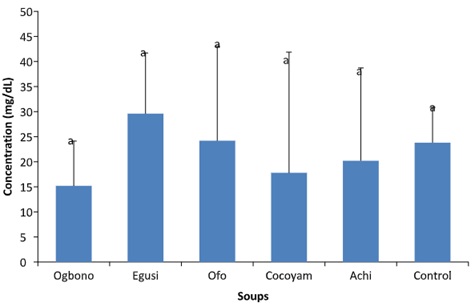 Figure 2: Effect of the soups on the post-prandial blood glucose level of the subjects after 30 min. Values are means ±standard deviation, n=5 per group. Bars with different letters (a,…) are significantly different at p≤0.05.
Figure 2: Effect of the soups on the post-prandial blood glucose level of the subjects after 30 min. Values are means ±standard deviation, n=5 per group. Bars with different letters (a,…) are significantly different at p≤0.05.
Figure 3 represents the effect of the soups on the post-prandial glucose level of the subjects after 60 min. All the thickeners produced substantial reduction effect in the post-prandial blood glucose level of the subjects after 60 min of consumption of test soups compared to the control. Detarium microcarpum soup produced the highest reduction effect with 6mg/dL. The statistical analysis showed that there was no significant difference between the soups with thickeners and the control soup.
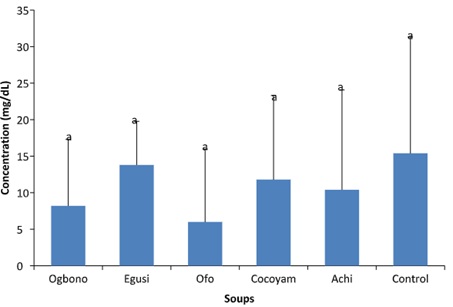 Figure 3: Effect of the soups on the post-prandial blood glucose level of the subjects after 60 min. Values are means ±standard deviation, n=5 per group. Bars with different letters (a,…) are significantly different at p≤0.05.
Figure 3: Effect of the soups on the post-prandial blood glucose level of the subjects after 60 min. Values are means ±standard deviation, n=5 per group. Bars with different letters (a,…) are significantly different at p≤0.05.
Figure 4 is showing the effect of the thickeners on the post-prandial blood glucose level of the subjects after 90 min. After 90 min of consumption of the test soups, Irvingia gabonensis soup was able to effect a reduction in the post-prandial blood glucose level of the subjects while the soups of Detarium microcarpum, Brachystegia eurycoma and the control soup greately increased the post-prandial blood glucose level of the subjects. Statistically, the soups of Irvingia gabonensis and Detarium microcarpum were significantly different at p≤0.05. All the soups were not significantly different from the control soup.
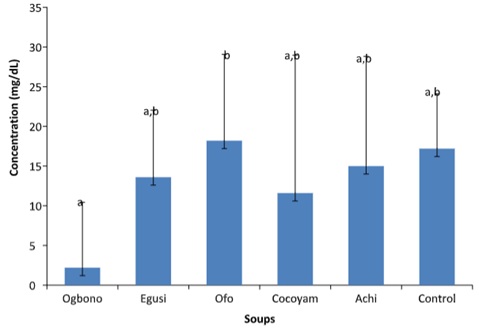 Figure 4: Effect of the soups on the post-prandial blood glucose level of the subjects after 90 min. Values are means±standard deviation, n=5 per group. Bars with different letters (a,b…) are significantly different at p≤0.05.
Figure 4: Effect of the soups on the post-prandial blood glucose level of the subjects after 90 min. Values are means±standard deviation, n=5 per group. Bars with different letters (a,b…) are significantly different at p≤0.05.
The effect of the soups on the post-prandial blood glucose level of the subjects after 120 min is shown in figure 5. The soups of Irvingia gabonensis, Citrullus vulgaries, Detarium microcarpum and Colocasis esculenta produced great reductions in the post-prandial blood glucose level of the subjects with the exception of Brachystegia eurycoma and the control soups which showed a effected a rise in the post-prandial blood glucose levels of the subjects. The soup thickeners are significantly not different at p≤0.05 when compared with the control sample.
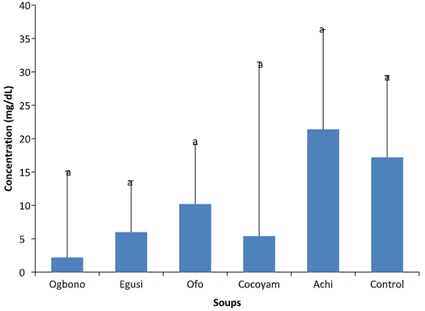 Figure 5: Effect of the soups on the post-prandial blood glucose level of the subjects after 120 min. Values are means ±standard deviation, n=5 per group. Bars with different letters (a,…) are significantly different at p≤0.05.
Figure 5: Effect of the soups on the post-prandial blood glucose level of the subjects after 120 min. Values are means ±standard deviation, n=5 per group. Bars with different letters (a,…) are significantly different at p≤0.05.
Figure 6 is showing the effect of the soup thickeners on the post-prandial blood glucose level of the subjects after 180 min of consumption of the test soups. All the soups are not significantly different when compared with the control sample. Irvingia gabonensis soup and Brachystegia eurycoma soup are significantly different at p≤0.05. With the exception of Irvingia gabonensis soup and Citrullus vulgaries soup which showed modest reduction, all of the soups produced substantial increase in the post-prandial blood glucose level of the subjects.
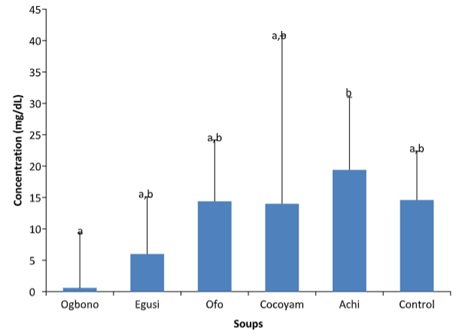 Figure 6: Effect of the soups on the post-prandial blood glucose level of the subjects after 180 min. Values are means±standard deviation, n=5 per group. Bars with different letters (a,b…) are significantly different at p≤0.05.
Figure 6: Effect of the soups on the post-prandial blood glucose level of the subjects after 180 min. Values are means±standard deviation, n=5 per group. Bars with different letters (a,b…) are significantly different at p≤0.05.
Discussion
In this study, the Irvingia gabonensis, Colocasia esculenta and Citrullus vulgaries soups consistently produced lower post prandial glucose levels in the participants, compared to the control soup. This could be attributable to their high crude fibre contents. Studies have shown that soluble viscous fibres have a positive effect of reducing postprandial glycaemia and thus may have a role in managing and preventing type 2 diabetes [11-13]. Amongst the crude fibres are the hydrocolloids or gum, which are a diverse group of long chain polymers characterized by their property of forming viscous dispersions and gels when dispersed in water [6]. According to [14], the digestive and viscosity characteristics of dietary fibres appear to nbe the likely modes of action, through which they decrease nutrient absorption, and thereby, decreasing metabolizable energy. The finding of this study, in respect of the Irvingia gabonensis soup (ogbono soup) is in conformity with the findings of [15], who reported that hydrocholloids physically function as soluble fibre when ingested and as such are effective in reducing blood cholesterol levels and moderating glucose response in diabetics.
Conclusion and Recommendations
Conclusion
In conclusion, the results obtained in this study indicated that the above uncharacterized plant foods indigenous to Nigeria have potential as dietary supplements for improving glycaemic control. As these foods are cheap, easily available and commonly used as food thickeners in rural Nigeria, they could be exploited for the treatment of diabetes in the more urban areas of Nigeria and other part of Africa where the prevalence of diabetes is currently a serious health problem. The Irvingia gabonensis in particular showed considerable promise. Irvingia gabonensis is likely to have other interesting nutritional properties that need investigating in human subjects.
Recommendations
The following are hereby recommended.
- That the effect of the soup thickeners on postprandial glucose levels be studied using others sources of starch.
- That the impact of gender on the effects of the soup thickeners be investigated.
References
- WHO (1999) Definition, diagnosis and classification of diabetes mellitus and its complications: Report of a WHO consultation. Part 1, Diagnosis and classification of diabetes mellitus. World Health Organization.
- Adogu POU, Ubajaka CF, Emelumadu OF, Alutu COC (2015) Epidemiologic transition of diseases and health-related events in developing countries: A review. American Journal of Medicine and Medical Sciences 5: 150-157.
- Onyechi UA (2010) The physiological effect of Detarium bread meal on the post-prandial profile of non-insulin dependent diabetes mellitus (NIDDM) subjects. Nigerian Journal of Nutritional Sciences 31: 47-52.
- Onyechi UA, Ibeanu VN, Ugwumba NG (2015) Blood glucose response of normoglycemic adults fed breakfast porridges made from Zea mays supplemented with Afzelia Africana, Detarium microcarpum or Sphenostylis stenocarpa. African Journal of Biotechnology 14: 3295-3233.
- Udenta EA, Obizoba IC, Oguntibeju OO (2014) Anti-diabetic effects of Nigerian indigenous plant foods/diets. Antioxidant-Antidiabetic Agents and Human Health 10: 5772-57240.
- Nwakaudu, AA, Nwakaudu MS, Owuamanam CI, Alagbaoso SO, Njoku NE, et al. (2017) Extraction and evaluation of hydrocolloids from “achi” (Brachystegia eurycoma) and its application on a water melon fruit juice. European Journal of Food Science and Technology 5: 22-28.
- Okwu GI, Achar PN, Ikenebomeh MJ, Sreenivasa MY (2011) Studies of food thickeners in Nigeria for contamination by aflatoxigenic forms of Aspergillus and their detection by PCR. African Journal of Biotechnology 10: 8641-8646.
- Akusu OM, Kiin-Kabari DB (2016) Effect of frozen storage on the chemical stability, functional and sensory properties of ‘Ogbono’ (Irvingia garbonensis excelsa) and ‘Egusi’ (Citrullus vulgaris Schrad) seed flours. American Journal of Food Science and Technology 4: 20-24.
- Oguntowo O, Obadina AO, Sobukola OP, Adegunwa MO (2016) Effects of processing and storage conditions of cocoyam strips on the quality of fries. Food Science and Nutrition 4: 906-914.
- Igwenyi IO, Asoro BN (2014) Proximate and phytochemical composition of four indigenous seed used as soup thickeners in Ebonyi state Nigeria. Journal of Environmental Science, Toxicology and Food Technology 8: 35-40.
- Jenkins AL, Kacinik V, Lyon M, Wolever TMS (2010) Effect of adding the novel fiber, PGX, to commonly consumed foods on glycaemic response, glycaemic index and GRIP: A simple and effective strategy for reducing postprandial blood glucose levels-A randomised, controlled trial. Nutr J 9: 58.
- Kendall CWC, Esfahani A, Jenkins DJA (2010) The link between dietary fibre and human health. Food Hydrocolloids 24: 42-48.
- Solah VA, O’Mara-Wallace B, Meng X, Gahler RJ, Kerr DA, et al. (2016) Consumption of the soluble dietary fibre complex PolyGlycopleX® reduces glycaemia and increases satiety of a standard meal postprandially. Nutrients 8: 268.
- Lattimer JM, Haub MD (2010) Effects of dietary fiber and its components on metabolic health. Nutrients 2: 1266-1289.
- Uhegbu FO, Onwuchekwa CC, Iweala EEJ, Kanu I (2009) Effect of processing methods on nutritive and antinutritive properties of seeds of Brachystegia eurycoma and Detarium microcarpum from Nigeria. Pakistan Journal of Nutrition 8: 316-320.
Citation: Onuoha SC, Ikewuchi JC, Okari AK, Chinaka OJ (2022) Management of Post-Prandial Blood Glucose Level Using Some Common Nigerian Thickeners. J Food Sci Nutr 8: 127.
Copyright: © 2022 Onuoha SC, et al. This is an open-access article distributed under the terms of the Creative Commons Attribution License, which permits unrestricted use, distribution, and reproduction in any medium, provided the original author and source are credited.

